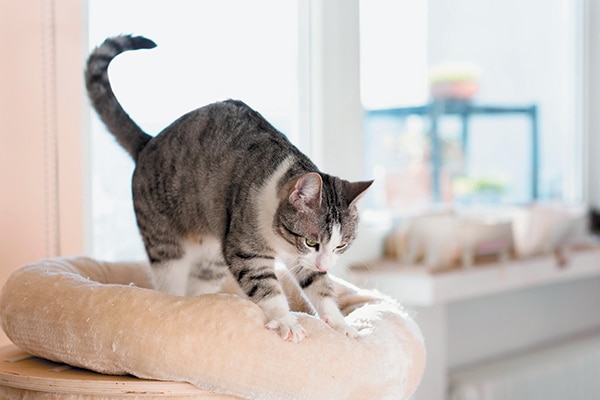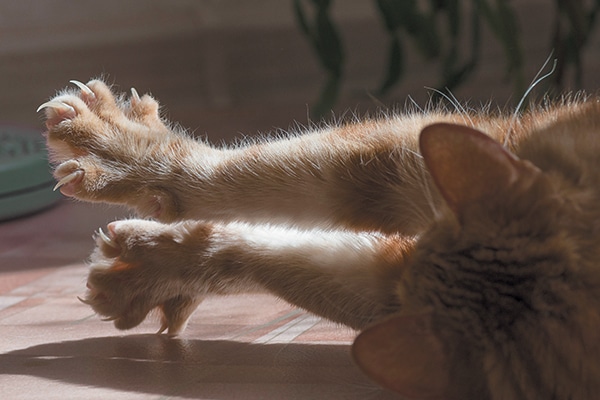Why do cats knead? Cats are interesting creatures, with many traits and behaviors that are easily recognized as being uniquely feline — the way they curl up tightly to take a nap, for example, or their characteristic grooming rituals after enjoying a meal. Cat kneading is another common feline behavior. The kneading is a motion cats make by pushing in and out with their paws, alternating between right and left. Some cats knead with claws completely retracted, while others will extend their claws as they push in and retract as they pull back. So, why do cats knead? Let’s take a look.

Why do cats knead? There are a few different reasons why cats knead. Photography ©Silvia Jansen | Alamy Stock Photo.
First, let’s look at how cats knead
Before we answer “Why do cats knead” let’s look at how they knead. Kneading is sometimes colloquially referred to as “making biscuits,” because the motion resembles a baker kneading dough. Cats almost always knead on a soft, pliable surface like a pillow, a comforter, another cat or kitten, or even your lap. Often cat kneading is accompanied by contented purring, and sometimes even by drooling as the cat relaxes his jaw. It’s not uncommon for a cat to be in an almost trance-like state as he kneads with a steady, rhythmic motion.
So, why do cats knead?
There are a few ways to answer the question, “Why do cats knead?” Explanations for why cats knead vary, but it is without doubt an instinctive trait. Newborn kittens knead their mother’s belly as they snuggle close to nurse, and the motion is thought to stimulate the flow of milk through her nipples. One rather outdated theory proclaims that cats that knead were separated from or weaned from their mother too early, and therefore continue the kittenish behavior into adulthood, yet nearly all adult cats knead, regardless of how or when they weaned. It’s more likely that the answer to “Why do cats knead?” is that it’s simply comforting to cats. (Although some cats do “suckle” the corner of a pillow or blanket while they are kneading.)
Kneading may also go back to the days when wild cats patted down tall grass or shredded leaves to make a soft, fluffy bed for sleeping or giving birth. Through the ages, the behavior continues to a natural part of cat instinct before settling down for a comfortable catnap.
There’s also a more practical aspect to answering the question, “Why do cats knead?” Cats have scent glands in the soft pads on the bottoms of their paws. When they knead, they release some of their unique scent onto the kneaded surface. That scent serves as a kind of territorial marker for any unfamiliar cats that might come along and try to stake a claim. So when your cat is kneading your lap, he’s not only telling you he feels comfortable and secure, but he’s claiming you as his own. (Scratching is also a natural part of cat instinct that results in the cat leaving his own residual scent behind, as well as a visual marker — claw marks — that other cats can recognize.)
What to do about cat kneading
Another question you might have after asking, “Why do cats knead?” is — “What should I do about cat kneading?” If your cat kneads you frequently, it’s a good incentive to keep those cat claws trimmed, in order to avoid being scratched or having your clothing snagged. You could also keep a folded towel next to your favorite chair, and use it to protect your lap as your cat kneads you with his paws.
If the kneading motion is uncomfortable enough to really bother you, you can try gently pulling your cat down into a lying position so he settles down and goes to sleep. Other tricks involve gently holding his front paws together, petting him, or distracting him with a toy or a treat. Pet behavior experts agree that it’s not appropriate to punish a cat for natural and instinctive behaviors like kneading.
Some female cats will knead frequently just before going into heat, as a signal to males of her willingness and ability to mate. As the estrus cycle continues, the cat will make plaintive meows that quickly escalate into loud, persistent yowls that are an effort to get the attention of a male. She may also pace restlessly, mark areas of your house with urine, become extremely affectionate and assume the mating position (head low, with raised hindquarters) when you pet her. It’s impossible to discourage these natural behaviors, and the best way to eliminate the symptoms associated with the female estrus cycle is to have your cat spayed.
Top photograph: Photography by VIZLAND/THINKSTOCK.
Tell us: Does your cat knead? What does he knead?
